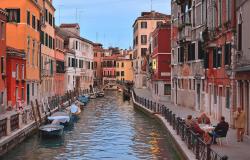The water flowing through Venice’s famous canals lapping against the majestic palazzi, creating that special charming atmosphere is getting a little higher every year. Although previous studies had shown Venice to have finally stabilised, new research findings indicate that La Serenissima is still sinking.
While acqua alta (flooding caused by high tides) is a common occurrence on the lagoon, and residents are forced to walk on raised wooden platforms numerous times during the year, there is more than discomfort at stake.
A new study carried out by the Scripps Institution of Oceanography at the University of California and recently published in the American journal Geochemistry, Geophysics, Geosystems, reports that the lagoon is sinking between 1 to 2 millimetres a year and is tilting slightly to the east. Venice’s islands, a total of 117, are subsiding even more quickly at an average rate of 2 to 3 mm, with the southern lagoon sinking at an alarming rate of 3 to 4 mm a year. The research team used a combination of GPS and space-born radar (InSAR) instruments to measure the lagoon’s movements from 2000 to 2010.
Decades ago, the sinking of the lagoon had been a major concern when scientists discovered that the pumping of groundwater from beneath the city was causing serious damage to the stability of the foundation. As a result, the practice was stopped and a study in 2000 reported that the city’s sinking had been halted.
Other harmful factors include the compaction of the ground due to hundreds of years of construction. In addition, scientists have noted the rising sea levels, a result of climate change, as a significant threat to the lagoon.
The recent study cited a new reason for concern – the Adriatic plate, including Venice, is shifting beneath the Apennines Mountains, resulting in the lowering of the elevation of the lagoon.
Efforts to protect the city include the building of floodwater gates, known as MOSE, which will automatically close when high tides reach a certain level. Other ideas include geo-engineering solutions, which propose pumping saltwater into the aquifers beneath Venice, hoping to reverse the effects of groundwater pumping.










